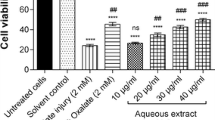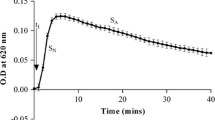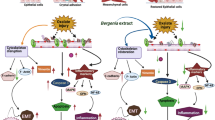Abstract
Urocalun®, a herbal medicine prepared from an extract of Quercus salicina Blume/Quercus stenophylla Makino (QS extract), has been clinically used for the treatment of urolithiasis in Japan since 1969. In the present study, the effects of QS extract on oxalate-induced cell injury and NADPH-induced superoxide anion (O2 −) production in the injured cells were investigated. Oxalate-induced cell injury was assessed by mitochondrial reduction of 3-(4,5-dimethyl-2-thiazol)-2,5-diphenyltetrazolium bromide and leakage of lactate dehydrogenase into the extracellular fluid. When NRK-52E cells were injured by exposure to oxalate for 24 h, QS extract prevented the injury in a dose-dependent manner. In addition, QS extract suppressed the increase in NADPH-induced O2 − production, or NADPH oxidase activity, in the homogenate of cells injured by oxalate exposure. These findings suggest that the reduction in oxalate-induced O2 − production contributes to the cytoprotective effect of QS extract.




Similar content being viewed by others
References
Finlayson B (1974) Symposium on renal lithiasis. Renal lithiasis in review. Urol Clin North Am 1:181–212
Wahl C, Hess A (2000) Kidney calculi–is nutrition a trigger or treatment? Ther Umsch 57:138–145
Natsukawa T, Hirata K, Noda K, Oka M, Tanaka M, Hamada K, Kuwabara T (2005) Promoting effect of extract of Quercus salicina Blume/Q. stenophylla Makino (UROCALUN®) on urinary stone passage. Jpn Pharmacol Ther 33:361–368
Ishigami J, Ooshima H, Saitou H (1967) Clinical effect of UROCALUN on urolithiasis in the upper urinary tract. Hifu to Hinyo 29:858–862
Ookita K, Yamada S, Johsen T, Tanaka M (1968) Uses of UC-2 for treatment of upper urinary calculi and studies on dissolution of urinary calculi by UC-2. Hifu to Hinyo 30:426–431
Huang HS, Ma MC, Chen J, Chen CF (2002) Changes in the oxidant–antioxidant balance in the kidney of rats with nephrolithiasis induced by ethylene glycol. J Urol 167:2584–2593
Selvam R (2002) Calcium oxalate stone disease: role of lipid peroxidation and antioxidants. Urol Res 30:35–47
Thamilselvan S (1998) Oxalate and calcium oxalate crystals are injurious to renal epithelial cells: results of in vivo and in vitro studies. J Nephrol 11(Suppl 1):66–69
Wiessner JH, Hasegawa AT, Hung LY, Mandel GS, Mandel NS (2001) Mechanisms of calcium oxalate crystal attachment to injured renal collecting duct cells. Kidney Int 59:637–644
Khan SR (1995) Calcium oxalate crystal interaction with renal tubular epithelium, mechanism of crystal adhesion and its impact on stone development. Urol Res 23:71–79
Rashed T, Menon M, Thamilselvan S (2004) Molecular mechanism of oxalate-induced free radical production and glutathione redox imbalance in renal epithelial cells: effect of antioxidants. Am J Nephrol 24:557–568
Thamilselvan S, Byer KJ, Hackett RL, Khan SR (2000) Free radical scavengers, catalase and superoxide dismutase provide protection from oxalate-associated injury to LLC-PK1 and MDCK cells. J Urol 164:224–229
Bradford MM (1976) A rapid and sensitive method for the quantitation of microgram quantities of protein utilizing the principle of protein-dye binding. Anal Biochem 72:248–254
Scheid C, Koul H, Hill WA, Luber-Narod J, Kennington L, Honeyman T, Jonassen J, Menon M (1996) Oxalate toxicity in LLC-PK1 cells: role of free radicals. Kidney Int 49:413–419
Thamilselvan S, Khan SR, Menon M (2003) Oxalate and calcium oxalate mediated free radical toxicity in renal epithelial cells: effect of antioxidants. Urol Res 31:3–9
Hackett RL, Shevock PN, Khan SR (1990) Cell injury associated calcium oxalate crystalluuria. J Urol 144:1535–1538
Ebisuno S, Kohjimoto Y, Tamura M, Ohkawa T (1995) Adhesion of calcium oxalate crystal to Madin-Darby canine kidney cells and some effects of glycosaminoglycans or cell injuries. Eur Urol 28:68–73
Schepers MS, van Ballegooijen ES, Bangma CH, Verkoelen CF (2005) Crystals cause acute necrotic cell death in renal proximal tubule cells, but not in collecting tubule cells. Kidney Int 68:1543–1553
Schepers MS, van Ballegooijen ES, Bangma CH, Verkoelen CF (2005) Oxalate is toxic to renal tubular cells only at supraphysiologic concentrations. Kidney Int 68:1660–1669
Miyazawa K, Suzuki K, Ikeda R, Moriyama MT, Ueda Y, Katsuda S (2005) Apoptosis and its related genes in renal epithelial cells of the stone-forming rat. Urol Res 33:31–38
Sarica K, Yagci F, Bakir K, Erbagci A, Erturhan S, Ucak R (2001) Renal tubular injury induced by hyperoxaluria: evaluation of apoptotic changes. Urol Res 29:34–37
Huang HS, Ma MC, Chen CF, Chen J (2003) Lipid peroxidation and its correlations with urinary levels of oxalate, citric acid, and osteopontin in patients with renal calcium oxalate stones. Urology 62:1123–1128
Thamilselvan S, Menon M (2005) Vitamin E therapy prevents hyperoxaluria-induced calcium oxalate crystal deposition in the kidney by improving renal tissue antioxidant. BJU Int 96:117–126
Byer K, Khan SR (2005) Citrate provides protection against oxalate and calcium oxalate crystal induced oxidative damage to renal epithelium. J Urol 173:640–646
Coe FL, Parks JH, Asplin JR (1992) The pathogenesis and treatment of kidney stones. N Engl J Med 327:1141–1152
Moriyama MT, Domiki C, Miyazawa K, Tanaka T, Suzuki K (2005) Effect of oxalate exposure on Madin-Darby canine kidney (MDCK) cells in culture. Urol Res 33:470–475
Umekawa T, Byer K, Uemura H, Khan SR (2005) Diphenyleneiodium (DPI) reduces oxalate ion- and calcium oxalate monohydrate and brushite crystal-induced upregulation of MCP-1 in NRK52E cells. Nephrol Dial Transplant 20:870–878
Atmani F, Farell G, Lieske JC (2004) Extract from Herniaria hirsuta coats calcium oxalate monohydrate crystals and blocks their adhesion to renal epithelial cells. J Urol 172:1510–1514
Campos AH, Schor N (1999) Phyllanthus niruri inhibits calcium oxalate endocytosis by renal tubular cells: its role in urolithiasi. Nephron 81:393–397
Srinivasan S, Pragasam V, Jenita X, Kalaiselvi P, Muthu V, Varalakshmi P (2004) Oxidative stress in urogenital tuberculosis patients: a predisposing factor for renal stone formation–amelioration by vitamin E supplementation. Clin Chim Acta 350:57–63
Author information
Authors and Affiliations
Corresponding author
Rights and permissions
About this article
Cite this article
Moriyama, M.T., Miyazawa, K., Noda, K. et al. Reduction in oxalate-induced renal tubular epithelial cell injury by an extract from Quercus salicina Blume/Quercus stenophylla Makino. Urol Res 35, 295–300 (2007). https://doi.org/10.1007/s00240-007-0114-4
Received:
Accepted:
Published:
Issue Date:
DOI: https://doi.org/10.1007/s00240-007-0114-4




